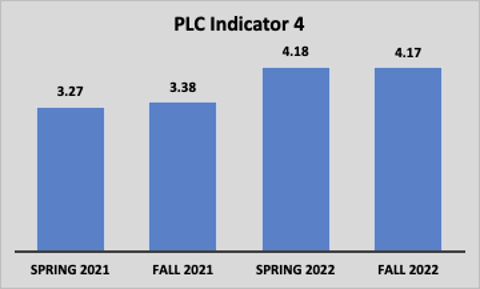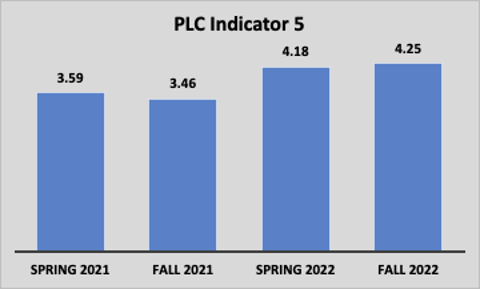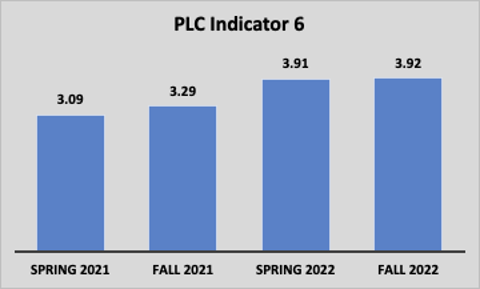How do the coaching strategies identified in DPI’s Coaching Competencies Practice Profile (CCPP) support shifts in adult professional learning community practices?
That’s the question we hoped to answer when partnering with the Wisconsin Evaluation Collaborative (WEC). Check out what we learned!
Participants in the Research to Practice Inclusive Communities (RPIC) project use both DPI’s Coaching Competency Practice Profile and the WI PLC Fidelity Rubric to identify, reflect, and inform professional practices. Coaches utilize the CCPP when working with district RPIC teams and in-district RPIC coaches. RPIC district team members use the PLC Fidelity Rubric when self-assessing their linked collaborative team processes. These tools provide a roadmap for the professionals that use them. But how do they align? How does the combined use of these tools support a shift in adult practices?
In order to demonstrate the relationship between the two, researchers from the Wisconsin Evaluation Collaborative (WEC) in partnership with the DPI’s RPIC program developed a crosswalk between the practices in the CCPP and the PLC Fidelity Rubric. The crosswalk helps to illustrate alignment of practices and helps inform the coherence of the RPIC work.
To examine if RPIC team practices were shifting as a result of coaches using strategies identified in the CCPP, WEC researchers looked at two pieces of data: 1) the PLC Fidelity Rubric self-assessment data from the RPIC teams and 2) the coaches' reflections submitted after each of their RPIC coaching sessions. From the coaching logs, researchers were able to tally the focus of each of the RPIC coaching sessions, illustrated in the table below.

As shown in the table, the coaching competencies most frequently used were communication skills (22), coaching conversation facilitation (15), and change facilitation (15).
Researchers then reviewed the crosswalk document mentioned earlier to identify the PLC Fidelity indicators that aligned with the competencies that were most frequently used. The following PLC indicators were identified as aligned with the most frequently utilized coaching competencies:
Communication Skills:
Aligned PLC indicators: Indicator 3: Collective Commitments, Indicator 4: Common School Goals, Indicator 5: Collaborative Culture, Indicator 6: Collaborative Culture, Indicator 7: Communicating Effectively
Coaching Conversation Facilitation:
Aligned PLC indicators: Indicator 1: Shared Mission, Indicator 2: Shared Vision, Indicator 4: Common School Goals, Indicator 5: Collaborative Culture, Indicator 6: Collaborative Culture, Indicator 10: Implementing the PLC Process Districtwide
Change Facilitation:
Aligned PLC indicators: Indicator 1: Shared Mission, Indicator 2: Shared Vision, Indicator 3: Collective Commitments, Indicator 4: Common School Goals, Indicator 5: Collaborative Culture, Indicator 6: Collaborative Culture, Indicator 7: Communicating Effectively, Indicator 9: Responding to Conflict, Indicator 10: Implementing the PLC Process Districtwide
There were three (3) indicators that consistently aligned across the three competencies.
- Indicator 4: Common School Goals
- Indicator 5: Collaborative School Culture
- Indicator 6: Collaborative Culture
For those three indicators, the PLC Fidelity Rubric self-assessments were plotted over time.
Table 2: Indicator 4: Common School Goals Over Time

Table 3: Indicator 5: Collaborative School Culture Over Time

Table 4: Indicator 6: Collaborative Culture Over Time

The takeaway is that over time, where coaching efforts were most focused, the aligned collaborative team practices grew!
The crosswalk and example highlighted here were presented to the RPIC CESA coaches during a DPI RPIC coaching monthly meeting, they discussed how the crosswalk resonated with their work, shared CCPP strategies they found to be successful in working with their RPIC teams, and identified ways that the crosswalk could guide their work going forward. One of the ways identified was using the crosswalk to help inform goal development related to the growth of their RPIC team practices. Coaches also noted that adding alignment to the relevant rubrics used by districts for Educator Effectiveness to the crosswalk could further add to its usability by demonstrating connections for educators. This could be a next step for this work.
In closing, the crosswalk helps demonstrate the connections between the CCPP and the PLC Fidelity Rubric. When applying the crosswalk to district specific data, we can then further describe how the focus of coaching efforts are impacting the RPIC collaborative teams they are working with.